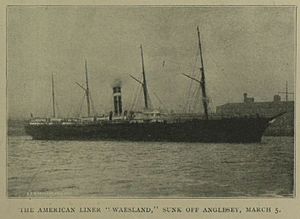SS Waesland facts for kids

As Waesland
|
|
Quick facts for kids History |
|
|---|---|
| Name |
|
| Namesake | Russia |
| Owner |
|
| Operator |
|
| Route | North Atlantic |
| Builder | J & G Thomson, Glasgow |
| Yard number | 93 |
| Launched | 20 March 1867 |
| Maiden voyage | 15 Jun 1867 |
| Identification | United Kingdom Official Number 12729 |
| Fate | Sunk after collision, 5 March 1902 |
| General characteristics | |
| Type | Liner |
| Tonnage | 4.752 GRT |
| Length | 109.1 m (358 ft) |
| Beam | 13.1 m (43 ft) |
| Propulsion |
|
| Sail plan | 3 masts |
| Speed | 14 kn (26 km/h; 16 mph) |
The SS Waesland was a large passenger ship, also known as a liner. It was first built as the Russia by J & G Thomson in Glasgow, Scotland. This ship had an interesting life, sailing across the Atlantic Ocean for many years.
The Early Years as SS Russia
The ship was launched on March 20, 1867. This means it was put into the water for the first time. Its very first journey, called its maiden voyage, happened in June of the same year.
A famous writer named Charles Dickens traveled on the Russia. He used the ship to return to England after visiting the United States. Dickens really liked the ship and praised it a lot.
On May 25, 1869, the Russia was involved in an accident. It ran into another ship called Figlia Maggiore near Bedloes Island in New York City. The Figlia Maggiore sank, but thankfully, no one lost their life in that incident.
A New Name: Waesland
In 1880, the Russia was sold to a different company called the Red Star Line. When it joined this new company, its name was changed to Waesland.
The Red Star Line also made some important changes to the ship. They replaced its original engine with a newer type called a compound engine. Later, in 1889, they upgraded the engine again to an even more advanced triple expansion engine. These changes helped the ship run more efficiently.
In 1895, the Waesland was rented out to the American Line. It was used for their routes that went to Philadelphia.
The Final Journey
The Waesland's long career came to an end in 1902. On March 5, 1902, it crashed into another ship named Harmonides. This accident happened off the coast of Anglesey, which is an island near Wales.
Sadly, the Waesland sank after this collision. Two people lost their lives in this final incident.
For many years, a painting of the ship, when it was known as the Russia, was displayed. It hung in the London offices of the Cunard company, showing its important history.

